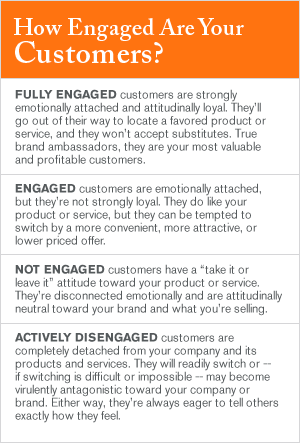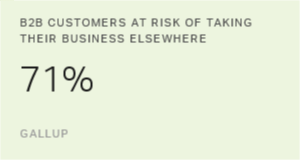If you asked business-to-business (B2B) companies what they do, most would tell you that they provide products and services to other companies -- and that doing this at the lowest possible price is the key to success. This is true. Quality service and products at a reasonable price is a basic component of operating a B2B company. But B2B organizations that see this as their only function are gravely misguided -- and easily replaced.
B2B companies that narrowly focus on product and price are doing the bare minimum required to survive.
Business-to-business companies that are narrowly focused on product and price are doing the bare minimum required to survive. Yet Gallup analysis shows that this approach is all too common -- the majority of B2B companies operate this way.
If your company wants to move beyond price wars, you need to rethink your mission and strategy. Being successful takes more than delivering a product or a service; it requires helping your customers succeed by improving their performance. The more your company can help your customers thrive, the stronger your partnership becomes. B2B companies that fail to understand how their products or services help their customers succeed lose two important competitive advantages: the steadfast advantage of customer engagement and the lucrative advantage of customer impact.
Creating customer engagement
Customer engagement goes beyond merely satisfying customers to provide an important foundation for creating customer impact. Gallup defines engagement as an emotional connection based on Confidence, Integrity, Pride, and Passion. Customer engagement is fundamental to customer impact because it establishes an element of partnership, which requires a genuine connection between your organization and its customers. (See graphic "How Engaged Are Your Customers?")

The idea of engaging customers may seem elementary, but few companies have mastered it -- though the value of doing more than just satisfying customers cannot be overstated. Fully engaged customers deliver a 23% premium over average customers in share of wallet, profitability, revenue, and relationship growth. Simply put, if you aren't creating an emotional connection with your customers, your organization's sustainability and growth will suffer.
A typical B2B company has an optimal relationship with fewer than one in seven of its customers. Gallup has conducted thousands of interviews over the last few years with B2B customers and has found that only 13% of B2B customers are fully engaged. At one professional services firm, for example, Gallup tracked the customer engagement scores across 75 of the company's top accounts in Year 0 (baseline) then compared those scores to account growth in Year 1. We found that low engagement scores were a prime indicator of future revenue decline:
-
Of the accounts with high engagement scores (at or above 4 out of a possible high score of 5), 21% of the accounts grew by 20% or more the next year, while 34% declined by 20% or more.
-
Of the accounts with low engagement scores (below 4 out of a possible high score of 5), 15% of the accounts grew by 20% or more the next year, while 60% declined by 20% or more.
Customer engagement levels give you the clearest view into the status of your company's accounts and are particularly efficient at identifying at-risk accounts. Given that most B2B companies must deal with long and sometimes inconsistent purchasing cycles while balancing multiple customer stakeholders, it could be easy to miss the warning signs that a customer relationship is becoming unstable. Without a process for regularly monitoring customer relationships, a company might not discover that it has a problem until a customer announces that it is reducing its contract size or taking its business elsewhere.
Creating customer impact
Even when a B2B company's product is highly commoditized, the organization has a distinct opportunity to establish a strategic advantage over its competitors by creating customer engagement and driving customer impact. Gallup defines customer impact as providing a meaningful change in a customer's business (or business processes) that significantly improves the customer's bottom line. It means helping a customer be more successful by doing business with your company than it could be by doing business with any other organization.
Success will come from recognizing the true business of a B2B company: creating an impact.
Creating impact requires providing a meaningful change in a customer's productivity or profitability. Sometimes, that impact comes from providing the customer with specific recommendations or other value-added solutions that:
-
allow the customer to use its products and services more efficiently or effectively
-
identify unseen product or service opportunities
-
enhance the customer's standing in the marketplace and thus its potential for future growth
-
have some broader effect on the customer's cost structure, perhaps through more effective supply chain management, inventory control, or process improvement
Companies that employ this strategic approach can shift their customer relationships from "price" to "advice." This requires a high level of expertise and in-depth knowledge of the organization and the marketplace in which it operates. To obtain this level of trust, B2B companies must:
-
know the customer's business
-
bring the customer new ideas
-
make those ideas work for the customer by tailoring them to the customer's marketplace and workplace
This advice-based approach deepens a customer relationship. It also provides a "stickiness" that is difficult to duplicate because it is often based on access that competitors won't have -- and it more than offsets the value of any proposed reduction in price.

Gallup recently analyzed the customer engagement and impact scores for the relationship managers (RMs) at a financial services company. Based on our analysis of a survey administered to the RMs' customer accounts, we found that customer engagement levels varied by RM -- but customer impact scores were universally low.
This was a surprise to the RMs, and many of them said that customer impact, as Gallup defines it, "wasn't really part of their job." From their perspective, their job was to sell and provide service to their accounts. Their supervisors agreed, saying that as a company, they had never really talked about their customers' business goals.
But within minutes of receiving this feedback, supervisors and RMs were talking about ways they could learn more about their customers' business goals and how they could support them. This discussion sparked an intellectual renaissance in the division. Within a week, the RMs were sending emails to their Gallup team outlining the conversations they were having with their customers, their reinvigorated relationships, and their optimistic plans for the future.
What leaders should do
Implementing a customer impact approach doesn't negate the importance of the functional drivers of engagement, particularly quality, utility, service, and responsiveness. Those elements, while essential, can be easily matched by your competition. To create impact, your organization must satisfy those functional requirements; generate high levels of emotional engagement; and produce tangible, positive, lucrative change for your customers.
If your organization wants to implement this approach, it's crucial to have a strategy to move forward. First, you must articulate what makes your company different from your competitors and reinforce that difference at every customer touchpoint. A lack of alignment costs time and energy and undermines customer impact.
Second, your organization should immediately start a dialogue with your most important customers. Ask them what their business goals are, then partner with them to find a way to solve their problems and meet their needs. Next, follow up by creating business-level plans with your account teams, building in accountability and performance metrics.
Developing and implementing a customer impact strategy takes real effort. It requires a new way of thinking and working, and it starts with a substantial investment in discussion and research internally and with key customers. It also requires your organization to revise its accountability plans, its performance metrics, and its own idea of success. Ultimately, success will come from recognizing the true business of a B2B company: It's more than selling a product -- it's creating an impact.

